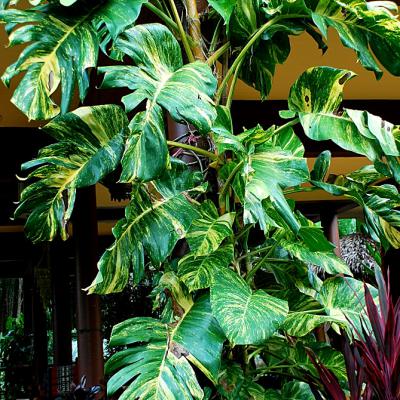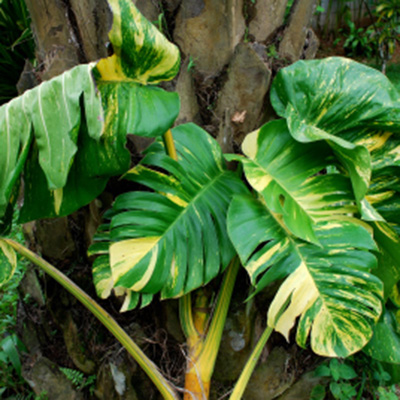Araceae-Epipremnum-aureum
Classification
- Botanical Family : Araceae
- Genus : Epipremnum
- Epithet : aureum
- German Family Name: Aronstabgewächse
- English Name: Devil's Ivy, Money Plant, Golden Pothos, Silver Vine,
- Thai Name: พลูด่าง
- Thai Phonetic: pluu daang
- Author: (Lind. & André) Bunting
Water Requirements
Plant Type
Light Requirements
Cultivation
Epipremnum aureum is an all-round talent.
It is a climbing plant that can grow up to heights of 20 metres. The plant has aerial roots. which climbs on trees or other supports, and it develops up to 4 cm thick stems. The aerial roots form hook-like extensions, which cling to in their natural habitat on the branches of trees. To be able to climb it needs climbing aids, such as tree trunks, posts, fences, trellises or walls.
Note: The aerial roots can not be removed completely again from columns or walls of houses and can damage them.
Epipremnum aureum grows in almost any soil, as well as in a vase filled with water, where it drives roots. As a young plant can be planted as ground cover in a shady area where the new shoots horizontally will soon have covered the soil. Or is suitable as a hanging plant for planting on slopes and embankments. Here, the plant can grow vertically suspended.
The plant thrives in pots in the garden and indoor as well.
If the plant is too big and spread too widely, it can be prune.
The leafes have a heart-shaped leaf blade, which are very disinct in young plants, in older plants, however the leafes are irregular divided. The leaves can be up to 100 cm long and 45 cm wide. The leafes of young plants are much smaller, typically less than 10 cm long.
This perennial herbaceous plant is evergreen. The leafes are green and have a striking yellow-or gold-colored marbling. There are several commercially subspecies with different pattern and leaf color, ranging from the almost entirely golden yellow to light green to creamy white.
Epipremnum aureum prefers bright shade or partial shade. The plant can tolerate weaker lighting and shadows, but the leaves lose their attractive colored pattern.The more a species is marbled, the more light it needs for healthy growth.
Can cope with constantly moist soil as well as with drier soils and a short drought.
All parts of this plant is poisonous because of the toxic calcium oxalate crystals, but toxic only if large quantities are eaten, resulting in severe pain in the mouth, lips, throat and tongue.
Propagation: by head-cuttings, which should have at least three leaf nodes. The cuttings can be put into the water where it drives roots or plant the cuttings directly on the new location. Up to rooting needs only slightly moist soil and keep the soil dry between waterings.
Epipremnum aureum ist ein Allround-Talent.
Es ist eine Kletterpflanze, die mittels Luftwurzeln bis in Höhen um 20 Meter an Bäumen oder anderen Stützen empor wachsen kann und dabei bis zu 4 cm dicke Sprossachsen entwickelt. Die Luftwurzeln bilden hakenähnliche Ausläufer, die sich in ihrem natürlichen Lebensraum an den Ästen von Bäumen festkrallen. Benötigt um klettern zu können, Kletterhilfen wie Baumstämme, Säulen, Zäune, Spaliere oder Hauswände.
Achtung: Die Luftwurzeln lassen sich von Säulen oder Hauswänden nicht restlos wieder entfernen bzw. können diese beschädigen.
Epipremnum aureum wächst in nahezu jeder Erde, wie auch in einer mit Wasser gefüllten Vase, wo es Wurzeln treibt. Kann als junge Pflanze als Bodendecker in schattiger Umgebung angepflanzt werden, wo die neuen Triebe horizontal bald die Erde bedeckt haben werden. Oder eignet sich auch als Hängepflanze zur Bepflanzung von Hängen und Böschungen. Hier kann die Pflanze senkrecht hängend wachsen.
Ebenso gedeiht die Pflanze in Töpfen im Garten wie auch im Haus.
Wird die Pflanze zu groß und zu mächtig in seiner Ausbreitung, kann sie bedenkenlos gekürzt werden.
Die Laubblätter haben eine herzförmige Blattspreite, die bei Jungpflanzen stark ausgeprägt, bei älteren Pflanzen jedoch unregelmäßig geteilt ist. Die Blätter können bis zu 100 cm lang und 45 cm breit werden. Die Blätter bei jungen Pflanzen sind viel kleiner, typischerweise weniger als 10 cm lang.
Diese ausdauernde krautige Pflanze ist immergrün. Die Blätter sind grün und haben eine auffallende gelb- oder goldfarbige Marmorierung. Es gibt im Handel verschiedene Subarten mit verschiedener Musterung und Blattfärbung, die von fast gänzlich goldgelb über hellgrün bis cremeweiß reicht.
Epipremnum aureum bevorzugt hellen Schatten oder Halbschatten. Die Pflanze verträgt schwächere Lichtverhältnisse und Schatten, die Blätter verlieren dann aber ihre attraktive Zeichnung. Je stärker eine Sorte marmoriert ist, umso mehr Licht benötigt sie für ein gesundes Wachstum.
Kommt mit stets feuchter Erde genauso zurecht, wie mit trockeneren Böden oder kurzer Trockenheit.
Alle Teile dieser Pflanze sind giftig aufgrund der vorhandenen Kalziumoxalatkristalle, die beim Verzehr von großen Mengen zu starken Schmerzen im Mund, Speiseröhre und Zunge führen kann.
Vermehrung: durch Kopfstecklinge, die mindestens drei Blattknoten haben sollten. Den Steckling kann man zur Bewurzelung ins Wasser stellen oder man pflanzt den Steckling direkt an Ort und Stelle. Bis zur Bewurzelung nur mäßig feucht halten und die Erde zwischen den Wassergaben abtrocknen lassen.
Origin
Miscelaneous
It is also efficient at removing indoor pollutants such as formaldehyde, xylene, and benzene. (1) A study found that this effect lessened the higher the molecular weight of the polluting substance.(2)
Epipremnum aureum ist auch bei der Beseitigung von Schadstoffen in Innenräumen, wie Formaldehyd, Xylol und Benzol effizient. (1) Eine Studie belegt diesen Effekt dadurch, dass sich die Höhe des Molekulargewichtes des Schadstoffes verringert. (2)
References
(1) Wolverton, B. C. How To Grow Fresh Air, Penguin Books, New York, 1997.
(2) Ayako Sawada, Takashi Oyabu, Purification characteristics of pothos for airborne chemicals in growing conditions and its evaluation, Atmospheric Environment, Volume 42, Issue 3, January 2008, Pages 594-602, ISSN 1352-2310, http://www.sciencedirect.com/science/article/pii/S1352231007009107


